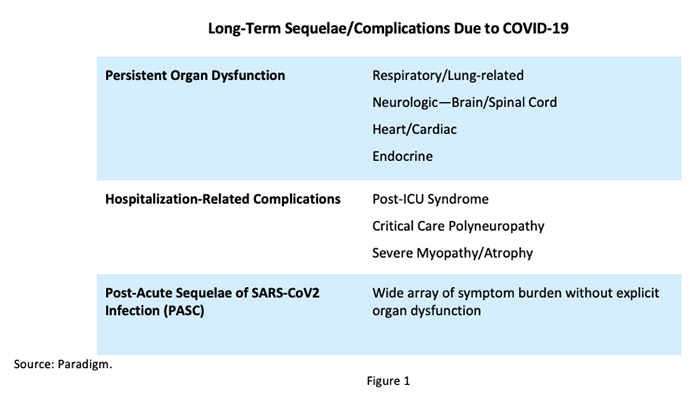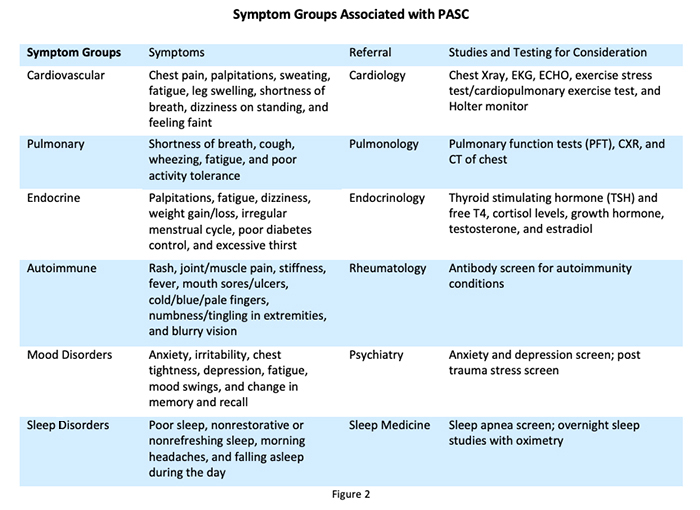National Council on Compensation Insurance (NCCI)
Full article on www.ncci.com
By: Michael Choo, MD, MBA, FACEP, FAAEM, Paradigm Chief Medical Officer
Introduction
It has been a year and a half since our nation declared the severe acute respiratory syndrome coronavirus-2 (SARS-CoV2) infection as a national emergency. But due to its evolving viral variants of concern, the COVID-19 pandemic still rages on in the US and around the globe. This novel infection surprised the nation and our medical community with its severe and devastating impact on multiorgan systems, necessitating high-intensity acute medical care and critical care. But, what is even more bewildering are the lingering debilitating effects from COVID-19 infection that are just now starting to be recognized.
New challenges: persistent symptoms
The US has nearly 45 million confirmed cases of COVID-19 infections as of October 25, 2021. Early in the pandemic, it was estimated that about one-fifth of those infected with the SARS-CoV2 virus would develop severe symptoms requiring hospitalizations, with up to 30% of those hospitalized requiring critical care in the intensive care unit (ICU).1 Those individuals needing prolonged hospitalization from severe illness involving their lungs, heart, brain, gastrointestinal tract, kidneys, or blood vessels can suffer chronic or persistent residual symptoms from permanent organ damages and/or physiological complications from prolonged hospitalization involving post-ICU syndrome and critical care polyneuropathy.
Published studies initially showed a majority or 81% of people with COVID-19 illness experienced mild to asymptomatic infections, while only 5% showed severe symptoms.2 Expected recovery time from COVID-19 infections was originally presumed to be two weeks for mild illness and longer for those with severe infections where acute organ damages are left with long-term issues. However, as the COVID-19 pandemic moves into its second year, the novel virus has surprised us yet again, as unexpected pandemic-related health consequences have emerged involving those with mild COVID-19 infections—troubled by a persistent and debilitating constellation of symptoms that have waxed and waned for many months following the initial acute infection.
Although survivors of severe COVID-19 illness have very high rates of persistent symptoms from permanent organ damages —up to 76% at six months;3 the growing concern is the projection that approximately 10% of people who contract mild COVID-19 infection will suffer from persistent symptoms well beyond four weeks.4 This post-COVID condition with prolonged symptoms has been referred to as long COVID, long haulers, chronic COVID, and post-acute COVID-19 in medical literature and the media. In recognition of the rapidly growing number of post-COVID-19 infected people with prolonged and persistent symptoms, the National Institutes of Health (NIH) ascribed a new term for this emerging chronic clinical syndrome—post-acute sequelae of severe acute respiratory syndrome—coronavirus 2 (SARS-CoV2) or PASC.5
The most puzzling aspect of PASC is the larger subset of individuals without any explicit organ-associated damage or biological causes that can easily explain or account for the persistent spectrum of symptoms prevalent well beyond 4–6 weeks in this post-COVID group. Furthermore, the potential number of people with PASC is most likely underestimated, especially with a growing number of published studies emerging in medical literature. Such studies indicate a much higher rate—up to 30% of COVID-19-infected individuals experience persistent symptoms lasting nine months or longer, where 84.7% of individuals with persistent symptoms had only mild COVID-19 illness.6 The rest of this article will focus on the different aspects of PASC.
Figure 1 provides a summary of three subgroups associated with persistent long-term sequelae from COVID-19 illness involving persistent organ dysfunction, prolonged hospitalization related complications, and those suffering from PASC without obvious organ damage.

Clinical symptoms of PASC
Many individuals with PASC experience an array of symptoms; in one recent study, patients reported having an average of 21 symptoms ranging from fatigue to personality changes.7 The spectrum of symptoms encompasses every body system, including respiratory, cardiovascular, musculoskeletal, endocrine, gastrointestinal, neurological, dermatological, and even psychological domains. Both published literature and treating clinicians managing individuals with PASC syndrome have identified the most common incapacitating elements to be:
- Severe fatigue with post-exertional or activity malaise
- Cognitive dysfunction classically known as “brain fog” involving impaired memory and concentration
- Palpitations with shortness of breath
Another barrier to recovery appears to be the relapsing and changing nature of these symptom combinations among afflicted individuals, which adds to the frustration of both the individual with PASC and their clinical providers.
Most recently, the American Academy of Physical Medicine and Rehabilitation Multi-Disciplinary PASC Collaborative published its consensus on grouping the common PASC system manifestations into six symptom groups—cardiovascular, pulmonary, endocrine, autoimmune, mood disorder, and sleep disorder. The PASC Collaborative also provided guidance as to diagnostic tests and studies including referral options for treatment interventions.8 The symptom groups in Figure 2 are in addition to studies standard for neurological conditions—e.g., brain MRI, cognitive testing, and neuropsychological testing.

Implications and recover timeline of PASC
This puzzling PASC condition is ultimately a diagnosis of exclusion resulting from a lack of any explicit association to organ pathophysiology. In addition, the experience of established PASC recovery centers confirm that an increasing number of medical comorbidities correlate to prolonged duration of symptoms regardless of age group. Hence, it is imperative that treating clinicians provide a comprehensive and holistic evaluation of the patient’s past and present health-related factors to ensure identification of other potential causes or contributors to persistent symptoms following acute COVID-19 illness.
The bright side is that many PASC-associated symptoms do seem to improve over time, though some resolve more slowly than others. Studies indicate olfactory (smell) and gustatory (taste) symptoms typically resolve within 2–4 weeks while fatigue, cognitive issues, chest tightness, and psychological effects can last for months—usually 3–6 months, but some beyond nine months.9 The frustrating reality is that the constellation of symptoms experienced by those with PASC for extended periods of time can significantly delay their ability to return to work and/or their prior level of function and impair quality of life.
Potential impact
In light of the increasing evidence that many individuals with PASC are those who recovered from mild COVID-19 infections, potentially millions of people could become functionally impaired for an extended period of time subsequent to acute COVID-19 illness. This is both sobering and alarming. To complicate the matter, the US Department of Health & Human Services and the US Department of Justice, in July 2021, provided guidance that the condition known as “long COVID” can be a disability protected under sections 504 and 1557 of the Americans with Disabilities Act (ADA) applicable to state and local government and public accommodations, respectively. Therefore, patients with PASC may in some circumstances be entitled to the same discrimination protections as any other person with a disability under the ADA.10 Since the actual number of people with long COVID or PASC is unknown, a critical question remains the size and scope of this issue with respect to potential impacts to our workforce, employers, and the US workers compensation industry.
This research brief represents the first of a two-part series that NCCI is planning to publish on long COVID. Work is underway to explore our rich data sources to identify long COVID claims, looking for trends in medical treatments and associated costs so we may report on the potential implications for workers compensation.
About the author
Dr. Michael Choo has been Chief Medical Officer and Senior Vice President for Paradigm since January 2013. He is responsible for Paradigm’s physician networks, centers of excellence, outcomes R&D, and continuous quality improvement. Dr. Choo is an emergency medicine instructor at Wright State University’s Boonshoft School of Medicine and a former CEO for Regional Care Hospital Partners.
About Paradigm
Paradigm is an accountable care management organization focused on improving the lives of people with complex and catastrophic injuries and diagnoses. The company has been a pioneer in value-based care since 1991, offering deep clinical expertise, high-value specialty networks, behavioral health support, payment integrity solutions, and robust data analytics to generate the very best outcomes for patients, payers, and providers.
Paradigm is headquartered in Walnut Creek, California, with offices across the US. For more information, please visit www.paradigmcorp.com.
1Citation: Oliveira E, Parikh A, Lopez-Ruiz A, Carrilo M, Goldberg J, Cearras M, et al., “ICU outcomes and survival in patients with severe COVID-19 in the largest health care system in central Florida.” PLoS ONE 16(3): e0249038. March 25, 2021. doi.org/10.1371/journal.pone.0249038
2Zeynab Yarijani et al., “Kidney injury in COVID-19 patients, drug development and their renal complications: Review study.” Journal Biomedicine & Pharmacotherapy. 142 (2021) 111966. October 2021. doi.org/10.1016/j.biopha.2021.111966
3Xue Zhang et al., “Symptoms and Health Outcomes Among Survivors of COVID-19 Infection 1 year after Discharge from Hospitals in Wuhan, China.” JAMA Network Open. 2021;4(9):32127403. 2021. jamanetwork.com/journals/jamanetworkopen/fullarticle/2784558
4Greenhalgh T et al., “Management of post-acute COVID-19 in primary care.” BMJ. 2020;370:m3026. August 11, 2020. www.bmj.com/content/370/bmj.m3026
5Collins, Francis S., MD, PhD, “NIH launches new initiative to study ‘Long COVID.’” February 23, 2021. www.nih.gov/about-nih/who-we-are/nih-director/statements/nih-launches-new-initiative-study-long-covid
6Logue JK et al., “Sequelae in Adults at 6 Months After COVID-19 Infection.” JAMA Network Open. February 19, 2021. jamanetwork.com/journals/jamanetworkopen/fullarticle/2776560
7Natalie Lambert, PhD et al., “COVID-19 Survivors’ Reports of the Timing, Duration, and Health Impacts of Post-Acute Sequelae of SARS-CoV-2 (PASC) Infection.” medRxiv preprint DOI. March 27, 2021. doi.org/10.1101/2021.03.22.21254026. www.medrxiv.org/content/10.1101/2021.03.22.21254026v1
8Joseph Herrera, et al.,“Multidisciplinary collaborative consensus guidance statement on the assessment and treatment of fatigue in post-acute sequelae of SARS-CoV-2 infection (PASC) patients.” American Academy of Physical Medicine and Rehabilitation. DOI: 10.1002/pmrj.12684. August 4, 2021. pubmed.ncbi.nlm.nih.gov/34346558/
9Nehme et al., “Prevalence of Symptoms More than Seven Months After Diagnosis of Symptomatic COVID-19 in an Outpatient Setting.” Annals of Internal Medicine. 2021.
10US Department of Health & Human Services and US Department of Justice, “Guidance on Long-COVID as a Disability Under the ADA, Section 504, and Section 1557.” July 26, 2021.